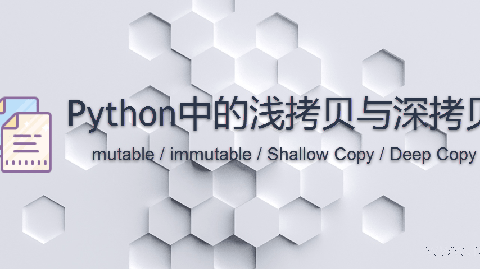Python 正则表达式 re 模块
Synopsis: 如果你想匹配的是字面字符串,那么你通常只需要调用基本字符串方法就行, 比如 str.find() , str.endswith() , str.startswith() 或者类似的方法。对于复杂的匹配需要使用正则表达式和 re 模块,如果你想使用同一个模式去做多次匹配,你应该先将模式字符串预编译为模式对象。match() 总是从字符串开始去匹配,如果你想查找字符串任意部分的模式出现位置, 使用 findall() 方法去代替
强烈推荐
正则表达式在线测试网站: https://regex101.com/
1. 标准库模块 re
更多详情参考官方文档:
Python3中使用re模块支持正则表达式(Regular Expression),需要定义一个用于匹配的模式(pattern)字符串,以及一个要匹配的字符串(string)。简单的匹配:
In [1]: import re In [2]: m = re.match('My', 'My name is wangy') In [3]: m Out[3]: <_sre.SRE_Match object; span=(0, 2), match='My'> In [4]: m.group() # 等价于m.group(0) Out[4]: 'My' In [5]: m.start(), m.end() Out[5]: (0, 2) In [6]: m.span() Out[6]: (0, 2)
其中,My是正则表达式模式,最简单的,只匹配字符My本身。而My name is wangy是想要检查的字符串,re.match()函数用于查看字符串是不是以正则模式开头。
如果你仅仅是做一次简单的文本匹配/搜索操作的话,可以直接使用 re 模块级别的函数,比如re.match。如果你打算做大量的匹配和搜索操作的话,最好先编译正则表达式,然后再重复使用它:
In [1]: import re In [2]: p = re.compile('[a-z]+') # [a-z]+ 是正则模式,表示1个或多个小写字母 In [3]: p Out[3]: re.compile(r'[a-z]+', re.UNICODE) In [4]: if p.match('hello123'): # p是预编译后的正则模式,它也有match等方法,只是参数不同,不需要再传入正则模式。判断字符串'hello123'是否以1个或多个小写字母开头 ...: print('yes') ...: else: ...: print('no') ...: yes In [5]: if p.match('123hi'): # 重用预编译过的正则模式 ...: print('yes') ...: else: ...: print('no') ...: no
模块级别的函数会将最近编译过的模式缓存起来,因此并不会消耗太多的性能, 但是如果使用预编译模式的话,你将会减少查找和一些额外的处理损耗。
1.1 使用match()从字符串开头开始匹配
可以使用模块级别的re.match()或预编译模式的p.match(),如果字符串是以正则表达式开头,则表明匹配成功,返回匹配到的对象,比如<_sre.SRE_Match object; span=(0, 2), match='My'>,如果匹配失败,返回None
In [1]: import re In [2]: m1 = re.match('wangy', 'wangy is a handsome boy.') # 模块级的match方法 In [3]: m1 # 匹配成功,返回Match对象 Out[3]: <_sre.SRE_Match object; span=(0, 5), match='wangy'> In [4]: m1.group() # Match对象有group()、start()、end()、span()等方法 Out[4]: 'wangy' In [5]: m2 = re.match('mayun', 'wangy is a handsome boy.') # 匹配失败 In [6]: type(m2) # 返回None Out[6]: NoneType In [7]: p = re.compile('wangy') # 预编译正则模式也是可以的 In [8]: p.match('wangy is a handsome boy.') # 调用预编译正则模式的match方法 Out[8]: <_sre.SRE_Match object; span=(0, 5), match='wangy'>
1.2 使用search()寻找首次匹配
如果字符串中有多个地方与正则表达式匹配的话,search()方法返回第一次匹配到的结果:
search(pattern, string, flags=0) Scan through string looking for a match to the pattern, returning a match object, or None if no match was found. (END)
In [1]: import re In [2]: s = 'I wish I may, I wish I might have a dish of fish tonight.' In [3]: re.search('wish', s) Out[3]: <_sre.SRE_Match object; span=(2, 6), match='wish'> In [4]: re.search('wish', s).span() Out[4]: (2, 6)
1.3 使用findall()或finditer()寻找所有匹配
前面两个函数都是查找到一个匹配后就停止,如果要查找字符串中所有的匹配项,可以使用findall()
In [1]: import re In [2]: text = 'Today is 11/27/2012. PyCon starts 3/13/2013.' In [3]: p = re.compile('\d+/\d+/\d+') In [4]: p.findall(text) Out[4]: ['11/27/2012', '3/13/2013']
findall()方法会搜索文本并以列表形式返回所有的匹配。 如果你想以迭代方式返回匹配,可以使用finditer()方法来代替,比如:
In [5]: iters = p.finditer(text) In [6]: iters Out[6]: <callable_iterator at 0x7f94c1703f98> In [7]: for m in iters: ...: print(m) ...: <_sre.SRE_Match object; span=(9, 19), match='11/27/2012'> <_sre.SRE_Match object; span=(34, 43), match='3/13/2013'>
1.4 使用split()按匹配切分
字符串的str.split()方法只适应于非常简单的字符串分割情形, 它并不允许有多个分隔符或者是分隔符周围不确定的空格。 当你需要更加灵活的切割字符串的时候,最好使用 re.split() 方法:
In [1]: import re In [2]: line = 'asdf fjdk; afed, fjek,asdf, foo' In [3]: re.split(r'[;,\s]\s*', line) # 正则模式表示 ;或,或空白字符且它们的后面再跟0个或多个空白字符 Out[3]: ['asdf', 'fjdk', 'afed', 'fjek', 'asdf', 'foo']
1.5 使用sub()替换匹配
对于简单的字面模式,直接使用字符串的str.replace()方法即可,比如:
In [1]: text = 'yeah, but no, but yeah, but no, but yeah'
In [2]: text.replace('yeah', 'yep')
Out[2]: 'yep, but no, but yep, but no, but yep'
对于复杂的模式,请使用re模块中的sub(),比如你想将形式为 11/27/2012 的日期字符串改成 2012-11-27 。示例如下:
In [1]: import re In [2]: text = 'Today is 11/27/2012. PyCon starts 3/13/2013.' In [3]: re.sub('(\d+)/(\d+)/(\d+)', r'\3-\1-\2', text) Out[3]: 'Today is 2012-11-27. PyCon starts 2013-3-13.'
sub()函数中的第一个参数是被匹配的模式,第二个参数是替换模式。反斜杠数字比如\3指向前面模式的第3个捕获组,此时要加r指定为原始字符串,否则会被Python自动转义为\x03
对于更加复杂的替换,可以传递一个替换回调函数来代替。一个替换回调函数的参数是一个Match对象,也就是match()或者find()返回的对象。使用group()方法来提取特定的匹配部分。回调函数最后返回替换字符串。比如:
In [1]: import re In [2]: from calendar import month_abbr In [3]: def change_date(m): ...: mon_name = month_abbr[int(m.group(1))] ...: return '{} {} {}'.format(m.group(2), mon_name, m.group(3)) ...: ...: In [4]: text = 'Today is 11/27/2012. PyCon starts 3/13/2013.' In [5]: p = re.compile(r'(\d+)/(\d+)/(\d+)') In [6]: p.sub(change_date,












0 条评论
评论者的用户名
评论时间暂时还没有评论.